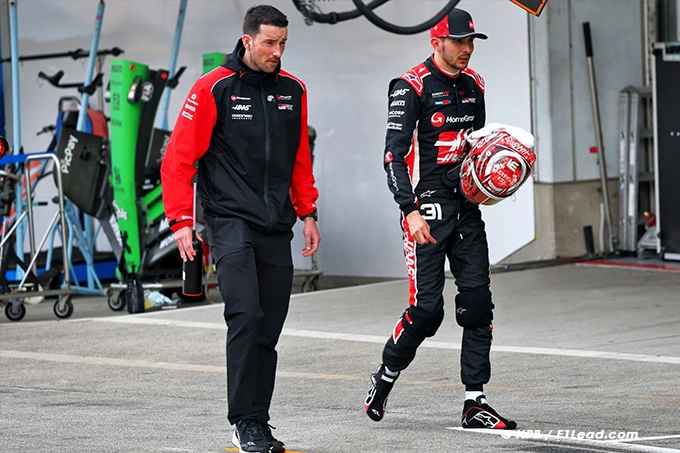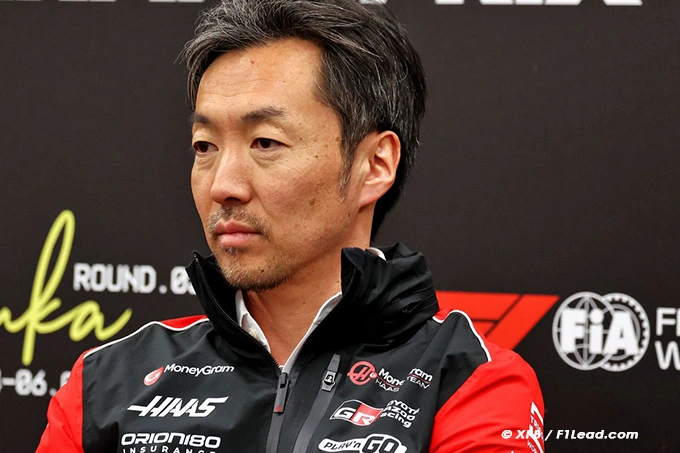Haas F1’s leadership shines through with Ocon and Bearman, as the team recovers from setbacks and secures crucial points in Shanghai.
After a disastrous Australian Grand Prix, where he had multiple off-track excursions, Oliver Bearman made a strong comeback in China with a clean weekend, no errors, and his first points of the season in the rain-soaked Shanghai circuit.
“I was really impressed,” said Ayao Komatsu, the team principal, speaking about his British driver.
Impressed, but not surprised, he continued.
“We always knew he was capable of this. Melbourne was a bit of a surprise, but we believed in his potential. We had a good conversation in Melbourne, and again before Shanghai. Essentially, we told him: ‘You have the talent, you have everything it takes to perform, just focus on executing each lap as planned this weekend.’ And that’s exactly what he did. He progressed with each step, learned from every session, and his performance on Sunday was incredible. That’s the Ollie we know. Like Andrea Kimi Antonelli, he still has a lot of potential and room to grow, which makes working with him exciting.”
Esteban Ocon also impressed and reassured the team in China. With a solid fifth-place finish (seventh before the Ferrari disqualifications), he earned crucial points for Haas F1.
“Once again, I really appreciate his work ethic,” Komatsu added.
Ocon has proven himself as a true team leader, according to the Japanese team principal.
“We know he’s fast. He’s a reliable asset. He finishes races and has earned a lot of points, but he’s still very young and extremely determined to achieve more in Formula 1. He’s someone we can grow with, especially when we face car issues like we did in Melbourne. Having a driver who’s fully integrated into the team, pushing the engineers – no matter how long it takes – and truly eager to improve together, makes a huge difference for the team. That’s exactly what I was hoping for, and it’s exactly what we’re seeing. I’m very happy about that.”
Why Is Haas F1 So Unpredictable?
But how to explain Haas F1’s dramatic inconsistency? How did the team go from disastrous performances in Australia to looking much stronger in Shanghai? Does Komatsu even fully understand his car?
“Oh yes, I think other top teams have faced similar issues in the past, but we’re handling it better. Last year, we thought we had put in place a good process and reliable indicators to avoid these kinds of difficulties. But even this year… We didn’t notice it in Bahrain; it was due to the specific corners. We saw some signs, but didn’t realize the severity. As soon as we hit Melbourne, it became quite clear.”
“But the good thing is, everyone accepted it and said, ‘Okay, we’ve got a big problem, we need to solve it.’ Then, we got to work to understand when we started deviating from the right path, and we aimed to bring something to Shanghai. So yes, it was a major issue. It’s still a major issue. I wouldn’t say we’ve fixed it. We didn’t see it here, but that doesn’t mean it’s resolved. So, the road ahead is still long.”
Komatsu admitted that the flat floor change this weekend carries some risks, as it has been very minimally tested. During free practice, initial impressions weren’t very promising – Haas F1 lost significant time in high-speed sections, particularly the Suzuka S’s.
“Yes, but the situation is quite different from Melbourne and Shanghai. Even when we look at sector 1, it’s not across the board. There’s one specific area where we’re lacking performance, and it’s not the same problem. We tested different floor specifications on both cars, and if the response had been completely conclusive, we would have standardized the cars. But honestly, that’s not the case. So, we’ll continue our testing program.”
“The issue isn’t as severe as it was in Melbourne, but we have another problem. As always: when you solve one, another appears. We need to act quickly as a team to make the car a bit more competitive.”
Has the Team’s Engineering Overhaul Yielded Results?
So, have the changes made to Haas F1’s engineering team this winter paid off? Komatsu, who has an engineering background, brings an advantage in this respect.
“I think it’s going very well. I did a lot more preparation before the season started—at the factory, working together without the real pressure, just focusing on the process: how we communicate, how we talk, learning to understand each other. Even during the pre-season tests in Bahrain, it was already clear. Of course, the first race in Melbourne would naturally have been tough to manage, but I was really happy to see that people stayed calm, communicated well, and did good work. Shanghai was another step. Again, we’re growing as a team. The important thing is to work together and support each other through difficult situations. I feel like we’re doing that, so yes, I’m very satisfied.”
Japan: The New Powerhouse in F1
Finally, Komatsu was asked about the situation of F1 in his home country, Japan. With Yuki Tsunoda at Red Bull, Honda involved, Ryo Hirakawa testing with Alpine F1, and Komatsu himself at Haas F1 (as well as Toyota Gazoo Racing), Japan has become a prominent nation in Formula 1 once again.
“I’m not sure if we’re a major nation yet, but there’s no doubt that after a dip in F1’s popularity here, interest is definitely on the rise. Again, what Yuki is achieving this year, and the fact that a Japanese driver could be aiming for a seat in a top team, is unprecedented. It’s a huge story and generating a lot of excitement here. Hirakawa is an excellent driver, and him taking part in EL1 – all these things are helping.”
“I also think the fact that the Grand Prix is in the spring plays a role. It’s not just one thing. I’ve heard that the Tokyo event was a big success. All these factors matter, and I only see positive signs. So, it’s an exciting time.”

- Discover More>Every Day Counts for Sauber Ahead of Its Transformation into Audi F1
- Follow us on >FACEBOOK and >TWITTERfor F1 updates
Ocon Leads Haas F1 to Strong Performance in China Ocon Leads Haas F1 to Strong Performance in China
